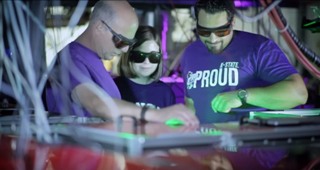Aug 19 2014
Kansas State University physicists and computer scientists are involved in a collaborative project to understand a long-lasting mystery: how light interacts with matter.
 Itzik Ben-Itzhak, university distinguished professor of physics, left, works with Bethany Jochim, doctoral student in physics, and Mohammad Zohrabi, doctoral student in physics. Ben-Itzhak is co-principal investigator on a multi-university project funded with a $6 million National Science Foundation grant.
Itzik Ben-Itzhak, university distinguished professor of physics, left, works with Bethany Jochim, doctoral student in physics, and Mohammad Zohrabi, doctoral student in physics. Ben-Itzhak is co-principal investigator on a multi-university project funded with a $6 million National Science Foundation grant.
Itzik Ben-Itzhak, university distinguished professor of physics, is a co-principal investigator on the multimillion-dollar project, Imaging and Controlling Ultrafast Dynamics of Atoms, Molecules, and Nanostructures. The project involves nine researchers in the university's physics and computer science departments as well as researchers at the University of Kansas and the University of Nebraska-Lincoln.
The National Science Foundation's Experimental Program to Stimulate Competitive Research, or EPSCoR, recently supported the project with a three-year, $6 million award. The grant is developing a regional Nebraska-Kansas consortium to understand how ultrafast laser technologies influence photonics and electronics.
The project — which focuses on atomic, molecular and optical physics — involves 30 physicists, chemists, computer scientists and electrical engineers from Kansas and Nebraska. The researchers will collaborate on imaging and controlling ultrafast dynamics of atoms, molecules and nanostructures.
"We want to see what light does to molecules so that we can try and use light to control molecular processes," Ben-Itzhak said. "We can use this knowledge to develop tools for useful future applications."
Some of these applications include scientific, technological, experimental and theoretical tools that can be used in laser technology, solar energy capture and nanotechnology.
For the project, researchers from Kansas State University's atomic, molecular and optical physics group are observing how fundamental systems react in strong laser fields. The researchers want to determine how to control strong laser fields and drive reactions in matter.
Kansas State University researchers involved in the project include Daniel A. Andresen, associate professor of computing and information sciences; Kevin Carnes, research professor of physics; Bret Flanders, associate professor of physics; Vinod Kumarappan, associate professor of physics; Anh-Thu Le, research associate professor of physics; Chii-Dong Lin, university distinguished professor of physics; Artem Rudenko, assistant professor of physics; Uwe Thumm, professor of physics; and Carlos Trallero, assistant professor of physics.
The Kansas and Nebraska consortium also is planning education, outreach and workforce development activities that involve small colleges in the two states, summer workshops for high school physics teachers and student programs.